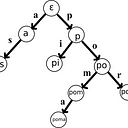Implementing a Bloom Filter Fast AF
Bloom filters are a probabilistic data structure that allows for fast membership checks of elements in a set. They are commonly used to reduce the amount of memory needed to store a large set of items, as well as to improve the speed of membership checks. In this tutorial, we will learn how to implement a bloom filter in Swift and understand how it works.
Implementation
To implement a bloom filter in Swift, we will start by creating a struct that represents the filter itself. This struct will have a few properties: a bit array to store the elements in the filter, a hash function to use for membership checks, and the size of the filter.
struct BloomFilter {
var bitArray: [Bool]
var hashFunction: (String) -> Int
var size: Int
}Next, we will add a method to our struct that allows us to add elements to the filter. This method will take in a string and use the hash function to calculate its hash value. It will then set the corresponding bit in the bit array to true.
extension BloomFilter {
mutating func add(_ element: String) {
let hashValue = hashFunction(element) % size
bitArray[hashValue] = true
}
}We also need a method that allows us to check if an element is in the filter. This method will take in a string and use the hash function to calculate its hash value. It will then check the corresponding bit in the bit array to see if it is set to true. If it is, we can return true, indicating that the element is likely in the filter. If it is not set to true, we can return false, indicating that the element is not in the filter.
extension BloomFilter {
func contains(_ element: String) -> Bool {
let hashValue = hashFunction(element) % size
return bitArray[hashValue]
}
}Finally, we can create an initializer for our BloomFilter struct that takes in a size and a hash function and initializes the bit array to all false values.
extension BloomFilter {
init(size: Int, hashFunction: @escaping (String) -> Int) {
self.bitArray = [Bool](repeating: false, count: size)
self.hashFunction = hashFunction
self.size = size
}
}With this implementation, we now have a basic bloom filter that can add elements to the filter and check for membership.
How it works
Now that we have implemented a bloom filter, let’s take a look at how it works.
A bloom filter uses a hash function to map elements to a fixed-size bit array. When an element is added to the filter, the hash function is used to calculate its hash value, and the corresponding bit in the bit array is set to true. To check if an element is in the filter, we use the hash function to calculate its hash value and check the corresponding bit in the bit array. If it is set to true, we can say that the element is likely in the filter.
One important thing to note about bloom filters is that they are probabilistic, meaning that they may produce false positives (indicating that an element is in the filter when it is not) but never false negatives (indicating that an element is not in the filter when it is). This means that while bloom filters are fast and efficient, they are not perfect and should not be used in cases where accuracy is critical.
Conclusion
Bloom filters are a useful data structure for improving the speed and efficiency of membership checks in large sets. In this tutorial, we learned how to implement a bloom filter in Swift and understand how it works.
If you want to learn more about bloom filters, you can check out the following resources:
- The Wikipedia page on bloom filters: https://en.wikipedia.org/wiki/Bloom_filter
- A detailed explanation of bloom filters on the IBM Developer website: https://developer.ibm.com/technologies/data/articles/bloom-filters/
- A bloom filter implementation in Python on the Real Python website: https://realpython.com/bloom-filter-python/
I hope this tutorial was helpful and you now have a better understanding of bloom filters and how to implement them in Swift. Happy coding!
